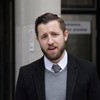Lviv Governor Maksym Kozytskyy posted this photo of a burning rail station in western Ukraine after a Russian missile strike Monday.
Russian airstrikes rained down on Ukrainian rail targets just after top U.S. officials left the country by train, following a secret meeting with President Volodomyr Zelenskyy.Both Secretary of State Anthony Blinken and Secretary of Defense Lloyd J. Austin III were in war-ravaged Kyiv for a face-to-face with Zelenskyy and his administration. The meetings were to, “demonstrate the United States’ unwavering commitment to Ukraine and the Ukrainian people in their struggle against Russian aggression,” according to a State department spokesperson.
Advertisement
But shortly after the two top Biden administration officials appeared back in neighboring Poland, the head of Ukraine’s state railway system, Oleksandr Kamyshin, reported that a number of airstrikes occurred across the country’s center and west.“This morning, within an hour, five railway stations in central and western Ukraine came under fire,” he said in a post on the Telegram messaging app, adding that there were victims and the situation was developing. “Russian troops continue to systematically destroy railway infrastructure.”Another Ukrainian government official said that the attacks had likely come from a Russian Tu-95 strategic bomber, with Ukrainian air defenses intercepting one of the missiles around the western city of Lviv, a hub for refugees and government. It is unclear if the bombings, which occurred much further west of the country and far from the Donbas region where the majority of the war is currently being fought, was directly related to the visit from Blinken and Austin.In recent days the Kremlin has stepped up its warnings to NATO and the U.S. for its escalation in arms transfers to the Ukrainian military. The Russian ambassador to Washington, Anatoly Antonov, has said the transfers were seen by the Kremlin as a provocation aimed at inflaming an already costly war. Meanwhile, Russia is not without its own recent taunts against the west: last week it tested a major new nuclear warhead capability that was celebrated on state television by President Vladimir Putin.While the Biden administration has continually maintained since the war began that no U.S. or NATO troops will enter the fight, it has stepped up its supply of weapons to Kyiv. Last week it helped provide aircraft parts, howitzer heavy guns, and over a 100 attack drones to Ukrainian forces as part of the billions in weapons transfers it has pledged. Blinken and Austin, who used Ukraine’s miraculously still-functioning railway system to arrive in the country, are the latest Western government officials who have traveled in person to meet with the government in Kyiv. British Prime Minister Boris Johnson previously did a similar secretive rail journey to meet with Zelenskyy. Russian forces have increasingly looked at the train infrastructure of Ukraine as a viable target and have killed multiple civilians in Kramatorsk, an embattled city in the east close to combat contactlines, after shelling a train station there where refugees gathered to to escape to Ukraine’s west.
